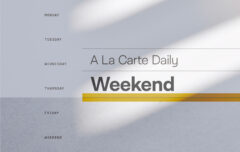Crucifixes have long been a fixture in Roman Catholic worship. But in the past few years I have begun to see more and more Protestants wearing them as well, exchanging their empty cross for one that contains an image of the suffering Savior. J.I. Packer once addressed the issue of the crucifix, and addressed it well.
What harm is there, we ask, in the worshipper surrounding himself with statues and pictures, if they help him to lift his heart to God?
We are accustomed to treat the question of whether these things should be used or not as a matter of temperament and personal taste. We know that some people have crucifixes and pictures of Christ in their rooms, and they tell us that looking at these objects helps them to focus their thoughts on Christ when they pray. We know that many claim to be able to worship more freely and easily in churches that are filled with such ornaments than they can in churches that are bare of them. Well, we say, what is wrong with that? What harm can these things do? If people really do find them helpful, what more is there to be said? What point can there be in prohibiting them? In the face of this perplexity, some would suggest that the second commandment only applies to immoral and degrading representations of God, borrowed from pagan cults, and to nothing more.
But the very wording of the [second] commandment rules out such a limiting exposition. God says quite categorically, “you shall not make an idol in the form of anything” for use in worship. This categorical statement rules out, not simply the use of pictures and statues which depict God as an animal, but also the use of pictures and statues which depict him as the highest created thing we know—a human. It also rules out the use of pictures and statues of Jesus Christ as a man, although Jesus himself was and remains man; for all pictures and statues are necessarily made after the “likeness” of ideal manhood as we conceive it, and therefore come under the ban which the commandment imposes.
Packer goes on to say that whatever else the second commandment teaches “there is no room for doubting that the commandment obliges us to disassociate our worship, both in public and in private, from all pictures and statues of Christ, no less than from pictures and statues of his Father.”
Why? Why is this prohibition in place and why is it so important that we heed it? He offers two reasons.
1. Images dishonour God, for they obscure his glory. The likeness of things in heaven (sun, moon, stars), and in earth (people, animals, birds, insects), and in the sea (fishes, mammals, crustaceans), is precisely not a likeness of their Creator. “A true image of God,” wrote Calvin, “is not to be found in all the world; and hence … his glory is defiled, and his truth corrupted by the lie, whenever he is set before our eyes in a visible form … Therefore, to devise any image of God is itself impious; because by this corruption his majesty is adulterated, and he is figured to be other than he is.” … The heart of the objection to pictures and images is that they inevitably conceal most, if not all, of the truth about the personal nature and character of the divine Being whom they represent.
…The pathos of the crucifix obscures the glory of Christ, for it hides the fact of his deity, his victory on the cross, and his present kingdom. It displays his human weakness, but it conceals his divine strength; it depicts the reality of his pain, but keeps out of our sight the reality of his joy and his power. In both these cases, the symbol is unworthy most of all because of what it fails to display. And so are all other visible representations of deity.
2. Images mislead us. They convey false ideas about God. The very inadequacy with which they represent him perverts our thoughts of him, and plants in our minds errors of all sorts about his character and will. … It is a matter of historical fact that the use of the crucifix as an aid to prayer has encouraged people to equate devotion with brooding over Christ’s bodily sufferings; it has made them morbid about the spiritual value of physical pain, and it has kept them from knowledge of the risen Savior.
These examples show how images will falsify the truth of God in the minds of men. Psychologically, it is certain that if you habitually focus your thoughts on an image or picture of the One to whom you are going to pray, you will come to think of him, and pray to him, as the image represents him. Thus, you will in this sense “bow down” and “worship” your image; and to the extent to which the image fails to tell the truth about God, to that extent will you fail to worship God in truth. That is why God forbids you and me to make use of images and pictures in our worship.
Image credit: Shutterstock. Quote drawn from Knowing God, chapter 4.










